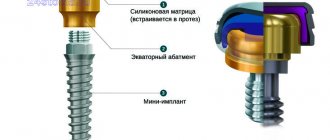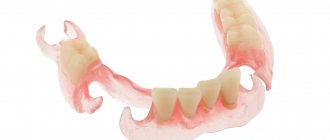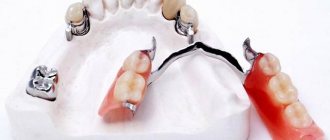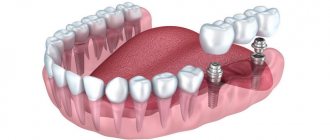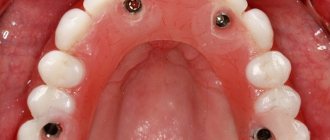Teeth are of great importance for both the aesthetic appearance of a person and the health of the entire body. Everyone tries to preserve them for as long as possible, maintaining their integrity and attractiveness. But not everyone succeeds in this. The optimal alternative to your own teeth may be a bar prosthesis on implants.
There are cases when a person at a fairly young age loses teeth for some reason. In such a situation, can we count on a return to the previous standard of living, or will we now have to impose a taboo on eating solid food, and cover our mouth with our hand when smiling? There is a way out - modern prosthetic methods. This includes the manufacture of a bar denture attached to 4 implants.
Features of the beam system for fixing prostheses
The principle of the technology is implied in the name - a complete removable overdenture is held on implants using a beam fastening. The titanium beam unites the installed implants, distributes the load between them and serves as an element for fixing the prosthesis. The second part of the mechanism is located in the prosthesis itself - a recess is provided in the base corresponding to the shape and size of the beam.
You can remove such a prosthesis yourself, but you do not need to do it every day, as with traditional removable prosthetics. 1-2 times a month is enough to clean the fixation elements.
The beam design is the most reliable of all removable denture options . The beam does not allow the fastening elements to become loose, and breakdowns are excluded. Accepts and evenly distributes vertical load, so bone tissue works not only at the site of implant installation, but throughout the entire jaw, which prevents bone atrophy. With proper use, such .
In most cases, the technology allows you to do without bone grafting and sinus lifting - points on the jaw with sufficient bone volume and density are selected to fix the implants.
Nuances of prosthesis maintenance
There is nothing overly complicated in the daily care of a conditionally removable denture. Unlike a regular removable product, there is no need to remove it after every meal. The design feature does not allow food particles to penetrate either under the beam or under the prosthesis.
The main efforts should be aimed at combating dental plaque. It is necessary to periodically clean the removable plate, fasteners and other structural elements with specially designed means.
At the final stage of prosthetics, the dentist explains in detail and shows how to brush your teeth correctly. Patients of the “People's Dentistry” clinic can seek advice at any time, even if the treatment is completed.
How many implants are needed?
The optimal number of implants is four per jaw . Allows you to correctly distribute chewing loads, avoid atrophy of bone tissue under the prosthesis, and increase the stability and efficiency of the entire structure.
We do not recommend a smaller number - in this case, implants are installed only in the frontal zone, the length of the beam is small. Accordingly, the prosthesis will be unstable in the lateral sections; constant balancing will lead to overload of the implants.
Sometimes six implants may be required for the upper jaw - the bone is softer and looser, so more supports are installed so that the load is distributed evenly.
How are implants installed?
First, the patient undergoes tests and undergoes x-ray diagnostics to exclude contraindications and draw up a treatment plan. The installation of implants is carried out using anesthesia - local (injection in the jaw) or intravenous. First, the gum flap is peeled off, then holes are drilled for the implants and fixed in the bone. After this (in most cases), the gum is sutured, and the patient goes home and recovers from the operation. Prosthetics will be performed in 3-6 months.
How is the operation to install dental implants performed?
If the bone tissue is dense enough, then prosthetics are possible within 3-7 days after the surgical stage. But, let us note once again that specifically for the beam type of prosthetics, immediate load is very rare.
Advantages of bar dentures
A denture with a bar fixation is the best solution of all the options for removable prosthetics on implants
- Convenience Smaller and lighter than traditional ones, more comfortable to use. They do not rest on the gums and do not injure them, and do not move while eating. Easy care.
- Simplicity Implants are placed in points with sufficient jawbone size. There is no need for expensive and complex bone grafting.
- Functionality The load is distributed evenly, the beam transmits pressure not only to the point around the implant, but also to the entire bone. Atrophy is excluded.
- Reliability The structure is strong, the fastenings do not become loose, high stability and chewing efficiency. With proper care it lasts a lifetime.
A prosthesis on a beam is the best of all removable prosthetic options on implants.
The design is reliable due to the beam fixation system. Holds securely and is not subject to overload or breakage.
Levin Dmitry Valerievich Chief physician and founder of the Doctor Levin center
Difference from fixed structures
You need to understand the difference between a removable beam prosthesis and a fixed prosthesis on implants. The beam can be removed by the patient independently, but the non-removable one cannot. And even a non-removable screw-mounted device cannot be removed by the patient himself - but this is not necessary. But an orthopedic dentist will be able to remove the structure with screws, so for the doctor it will be conditionally removable.
There are also non-removable orthopedic structures on a metal frame or beam, which are “hidden” inside the prosthetic base - they are a single whole and cannot be separated. Such modifications can be used for implantation according to the All-on-4, All-on-6 protocols, and the zygomatic technique. And for the All-on-3 or Trefoil protocol from Nobel Biocare, a unique metal beam is used, which is “embedded” in the prosthesis during manufacturing.
Differences between removable and fixed beam prosthesis. Photo: Smile-at-Once.ru
Stages of prosthetics
Prosthetics itself takes place in one day “in a dream” - we remove failing teeth, install implants, and fix the dentures.
Planning and diagnostics
In our Center, the entire structure is designed by an orthopedic dentist - he calculates the implantation points on the jaw so that after installing the prosthesis, the load is distributed evenly and the principles of biomechanics are observed. It is he who sets the task for the surgical department. This approach guarantees the final result and prevents possible breakdowns of the prosthesis.
The data for calculations are the results of diagnostic studies. Our Center carries out 2 types of diagnostics:
- Computer examination using a 3D tomograph Allows you to evaluate the size of the jaw bone and find suitable points for implantation. The data is also used for 3D surgical planning and production of a surgical template for error-free implant placement.
- Bite studies in an articulator In the absence of teeth, it is difficult to determine the correct closure of the jaws. The only reference point is the position of the TMJ, which is determined as a result of the study. Manufacturing a prosthesis taking into account this parameter ensures a physiological bite after prosthetics and normal functioning of the joint.
Installation of implants and immediate prosthetics
Implantation and removal of failing teeth (if any) are performed under sedation. The operation lasts 1-2 hours. All this time, the patient is in a state of controlled drug sleep, so he can easily endure all the inconveniences.
Immediately after the operation, digital impressions are taken using an intraoral scanner and instantly transferred to the technician in the laboratory. After 2-3 hours, the finished prosthesis is installed on the implants .
This is a temporary lightweight prosthesis - it is not recommended to immediately load implants with a heavy beam structure, because they may become dislodged as a result of strong pressure. Under a small load, the implants take root calmly and safely, a bite is formed, which is taken into account when making a permanent prosthesis.
Permanent prosthetics
After six months, the implants stabilized in the jaw are united by a beam onto which the prosthesis is fixed. In our Center, the beam is milled - it differs from cheaper ones (made by casting or welding) in its high precision of fixation and is not subject to breakage.
The permanent prosthesis is made after prototyping (trying on), the individual bite is taken into account, which eliminates joint and muscle problems during operation.
Crowns as part of the design look natural and are made with individual colors for each patient.
High-quality prosthetics on implants is the result of teamwork among doctors. Each specialist of our Center performs his task in accordance with the Unified Quality Standards and bears responsibility for it.
What are the disadvantages?
To discover the negative aspects of removable beam prostheses, you need to compare them with fixed orthopedic structures on implants. Thus, the following disadvantages become visible:
- shorter service life of the prosthetic structure and implants: higher risk of loosening of the implants, breakage of the product - after all, it has to be removed and put on using physical effort (which is not always calculated correctly),
- lower aesthetics of the restored smile: artificial teeth are made only from plastic, and on fixed structures they are made from ceramic composite, metal-plastic, zirconium dioxide,
- you cannot use the patient’s old prosthesis with which he walked before: with modern implantation protocols with fixed prosthetics this is possible - however, the structure must be in good condition,
- more complex hygiene and the need for regular removals,
- immediate prosthetics are used very rarely: immediate installation of an orthopedic structure on implants is possible only if the jaw bone is sufficiently dense. If it is soft and porous, then you will have to wait for the implants to engraft – it occurs in 3-6 months. During this period, the patient must be content with a conventional “puller” with fixation on the gums.
Bite examination in the articulator
Functional diagnostics are performed using a facebow and an articulator SAM3, Protar or Amann Girrbach.
- Determining the line of jaw closure
- Taking into account individual bite when making a prosthesis
- Prevention of joint overload after prosthetics
Doctors
Our dentistry is one of the best in Belarus. The popularity of the center is associated with good equipment, service, and highly qualified doctors. In total, dentists have 195 years of experience. Academic knowledge and experience, training in the offices of companies presenting new dental technologies, contribute to the improvement of professional skills. Doctors provide free consultations and provide information on popular prosthetic methods and select options for specific cases. For questions about pricing policy and treatment, you can contact the operator on the website.
Accelerated rehabilitation program
For those who want to speed up the recovery process, an accelerated rehabilitation program has been developed.
- Lymphatic drainage. Biostimulants improve lymph flow, relieve swelling and inflammation, improve healing
- PRP plasma lifting. Concentrated blood plasma relieves inflammation, resolves hematomas and swelling
- Microcurrent therapy. Improves tissue regeneration, reduces pain, relieves muscle microspasms
More details
General overview
The list of elements included in the system includes:
- Implants made of biologically compatible material;
- A specially shaped beam made of metal;
- A retainer (abutment) connecting the prosthesis and the base.
The main ideas behind the development of the beam-type system were effective load distribution and fastening of dentures. The metal beam equalizes the mechanical pressure that occurs during chewing food, preventing imbalance of artificial crowns and maintaining a tight connection between the base and the conditionally removable structure. For fixation, special locks are used that are invisible from the outside.
Life time
We work with premium Nobel Biocare implants, and together with the manufacturer we provide a lifetime warranty in the Dr.Levin Lifetime Warranty on the work and the systems themselves.
The service life of the prosthesis depends on compliance with the operating rules. According to statistics, the service life is from 15 years. If you follow the care recommendations and do not miss appointments every six months for routine maintenance, the structure will last a lifetime .
Even if something happens to the prosthesis, it can be replaced (and the beam, if necessary, too). The implants themselves are not removed; a new prosthesis can be installed on them.
Indications
- Completely edentulous. In this case, teeth are completely absent on one or both jaws.
- Partial adentia, accompanied by strong mobility of the preserved teeth. Severely loose teeth are not suitable for fixation of orthopedic structures. In this case, it is more advisable to remove them and install a beam prosthesis on implants.
Sometimes beam prostheses are installed after the patient has already had removable prosthetics. Removable covering structures may cause discomfort while wearing. If you have not been able to get used to the design for a long time, we recommend that you consult an orthopedist for consultation.
Varieties
With rectangular profile
The rectangular beam, which became widespread, was first invented by K. Rumpel. Its peculiarity is that the main pressure is transferred to the beam and only a small part falls on the mucous membrane of the alveolar process. There is a gap of 1–2 mm between the bar and the gum to perform hygienic procedures.
With an ovoid profile
The beam structure, developed by E. Dolder, has an ovoid profile with a height of 3 mm and a width of 2 mm. A metal strip 0.2 mm thick acts as a bushing. The gap between the middle of the bushing and the highest point of the beam is 1 mm. As chewing load increases, the sleeve moves, thereby improving the functionality and performance of the system.
With T-profile
Research conducted by Selchukov S.G. allowed us to come to the conclusion that the T-shaped profile has the least deflection compared to other structures. The beam made of cobalt-chrome-nickel alloy is attached to push-button cylindrical locks and is equipped with platforms along the entire length. The matrix is made of polypropylene. In order to improve the shock-absorbing and fixing properties of the system, a gap of 1 mm is left between the upper part of the beam and the matrix. Push-button locks provide reliable adhesion to the supporting teeth, which generally has a positive effect on the strength of the structure.
With cast blanks
The first use of cast blanks for a beam-type prosthesis was proposed by RT Williamson in 1991. Their installation required preliminary processing of the remaining teeth. Its goal was to obtain smooth surfaces without sharp corners and an occlusal gap for fixation of artificial units.
Then plastic pins are inserted into the previously prepared root canals for the subsequent production of their metal counterparts. The cavities into which the pins will be installed are covered with cotton balls and a bandage, which eliminates the risk of infection. Based on the impressions obtained, metal pins are cast, which, after polishing, are fixed to the patient. If necessary, correction is carried out, and then a prosthesis is made by a specialist in a dental laboratory. After polymerization of the plastic base, the prosthesis is ground and polished. Replacement clamps are then installed. This technique significantly reduces the cost of prosthetics, and also improves the fixation of the structure and the condition of the periodontium by shortening the crown.


